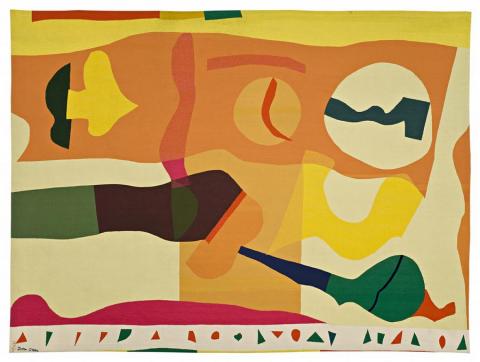YELLOW SUMMER, 1966
John Olsen
woven wool tapestry
264.5 x 356.5 cm (irregular) edition: 1/3
inscribed lower left: John Olsen
monogram inscribed lower left: MTP fino (Manufactura de Tapecarias de Portalegrel - Portalegre Tapestry Workshop, Portugal)
label attached verso: 1150 - 1 / 3
Sotheby’s, Sydney, 16 August 1999, lot 138 (as Abstract)
Company collection, Sydney
The following excerpts are quoted from Hart, D., John Olsen, Craftsman House, Sydney, 1991, pp. 83, 89.
‘With the success of the Joie de Vivre tapestry, John Olsen was enthusiastic about the prospect of continuing to work in this medium and was keen to deepen his knowledge of the history and process of tapestry-making by travelling to Europe to see the great exponents of this art first-hand. He departed in July 1965 with the principal aims of visiting the tapestry ateliers in France and Portugal…
From New York, Olsen went to France where, together with Frank McDonald, he spent several weeks visiting the renowned Gobelins and Aubusson tapestry ateliers… They then travelled to Portugal, to the atelier at Portalegre (where Olsen's Joie de Vivre tapestry had been woven), and were joined there by the artist Arthur Boyd, who had also become interested in exploring the field of tapestry design in his art.
The Portalegre atelier was continuing a long tradition dating back to 1771, when a weaving mill was established in the former ‘Colegio Sao Sebastiao’ built by the Jesuits in the seventeenth century. In the twentieth century, the workshop developed a reputation under the management of the firm Francisco Fino Ltd, with each succeeding administration taking pride in keeping their methods up to date and seeking a worldwide market. Olsen and MacDonald had a preference for the work methods at Portalegre, which they considered more flexible in interpreting the range of the artist's palette than Aubusson. It was also economically more viable. Olsen decided to return to Portugal the following year to work for an extended period with the weavers…
During the last few months of 1966, Olsen worked closely with the tapestry weavers at Portalegre. In the course of the previous months he had been developing designs for three new tapestries: Nude with Clock, Yellow Summer and Verdure. In 1965… he…received a commission for the Australia Square building in Sydney designed by Harry Seidler. Olsen decided that the public spaces in which the tapestries would be hung precluded the need for concentrated attention from the viewer and that the works should be monumental in their formal implications…
This structural emphasis is reflected in Nude with Clock, in which the striking, simplified shapes and curving, sensual silhouettes recall some of Matisse's late cut-outs. However, as in Yellow Summer, there is an obvious formal restraint, a curbing of Olsen's characteristic spontaneity, which separates these works from the earlier tapestry, Joie de Vivre…’
